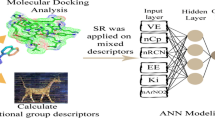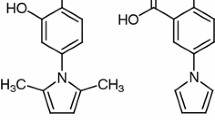Summary
A quantitative–structure activity relationship was obtained by applying Multiple Linear Regression Analysis to a series of 80 1-[2-hydroxyethoxy-methyl]-6-(phenylthio) thymine (HEPT) derivatives with significant anti-HIV activity. For the selection of the best among 37 different descriptors, the Elimination Selection Stepwise Regression Method (ES-SWR) was utilized. The resulting QSAR model (R 2 CV = 0.8160; S PRESS = 0.5680) proved to be very accurate both in training and predictive stages.
Similar content being viewed by others
References
Hansh, C. and Leo, A. Exploring QSAR. Fundamentals and Applications in Chemistry and Biology. American Chemical Society. Washington, DC, 1995.
Miyasaka, T., Tanaka, H., Baba, M., Hayakawa, H., Walker, R., Balzarini, J. and Clercq, E. A novel lead for specific anti-HIV-1 agents: 1-[(2-hydroxyethoxy)methyl]-6-(phenylthio)thymine. J. Med. Chem., 32 (1989) 2507–2509.
Hansch, C. and Zhang, L. Bioorg. QSAR of HIV inhibitors. Med. Chem. Lett., 2 (1992) 1165–1169.
Hannongbua, S., Lawtrakul, L. and Limtrakul, J. Structure –Activity Correlation Study of HIV-1 Inhibitors. Electron and Molecular Parameters. J. Comput. –Aided Mol. Des., 10 (1996) 145–152.
Tanaka, H., Takashima, H., Ubasawa, M., Sekiya, K., Nitta, I., Baba, M., Shigeta, Sh., Walker, R.T. De Clercq, E., Miyasaka, T. Synthesis and Antiviral Activity of 6-Benzyl Analogs of 1-[(2-Hydroxyethoxy)-methyl]-6-(phenylthio)thymine (HEPT) as Potent and Selective Anti-HIV-1 Agents. J. Med. Chem., 35 (1992) 4713–4719.
Luco, J.M. and Ferreti F.H. QSAR Based on Multiple Linear Regression and PLS Methods for the Anti-HIV Activity of a Large Group of HEPT Derivatives. J. Chem. Inf. Comput. Sci., 37 (1997) 392–401.
Jalali-Heravi., M. and Parastar., F. J. Use of Artificial Neural Networks in a QSAR Study of Anti-HIV Activity for a Large Group of HEPT Derivatives, Chem. Inf. Sci., 40 (2000), 147–154.
Alves, C. N., Pinheiro, J. C. Camargo, A. J., Ferreira, M. M. C. and Silva, A. B. F. A structure –activity relationship study of HEPT –analog compound with anti –HIV activity. Journal of Molecular Structure (Theochem), 530 (2000) 39–47.
Bazoui, H., Zahouily, M., Boulajaaj, S., Sebti, S. and Zakarya, D. QSAR for anti-HIV activity of HEPT derivatives. SAR and QSAR in Environmental Research, 13 (2002) 567–577.
Duali, L., Villemin, D. and Cherqaoui, D., Neural Networks : Accurate Nonlinear QSAR Model for HEPT Derivatives, J. Chem. Inf. Comput. Sci., 43 (2003) 1200–1207.
Duali, L., Villemin, D. and Cherqaoui, D., Comparative QSAR based on neural networks for the anti-HIV activity of HEPT derivatives. Curr. Pharm. Des., 9 (2003) 1817–1826.
Duali, L., Villemin, D., Zyad, A. and Cherqaoui, D., Artificial neural networks: non-linear QSAR studies of HEPT derivatives as HIV-1 reserve transcriptase inhibitors. Molecular Diversity, 8 (2004) 1–8.
Gupta, S., Singh, M. and Madam, A. K., Predicting anti-HIV activity: computational approach using a novel topological descriptor. J. Comput. Aided Mol. Des., 15 (2001) 671–678.
Gayen, S., Debnath, B., Samanta, S. and Jha, T., QSAR study on some anti-HIV HEPT analogues using physicochemical and topological parameters. Bioorganic & Medicinal Chemistry, 12 (2004) 1493–1503.
Efroymson, M. A., Multiple Regression Analysis, in: Ralston, A. and Wilf, H.S. (eds.), Mathematical Methods for Digital Computers, Wiley, New York, NY, 1960.
Osten, D. W. Selection of Oprimal Regression Models via Cross-Validation J. Chemom., 2 (1988) 39–48
Wold, S. and Eriksson, L., Statistical Validation of QSAR Results, in: Van de Waterbeemd, H. (Ed.), Chemometrics Methods in Molecular Design, VCH Weinheim (Germany), 1995, pp. 309–318.
Tropsha, A., Gramatica, P. and Gombar, V. K., The Importance of Being Earnest: Validation is the Absolute Essential for Successful Application and Interpretation of QSPR Models. Quantitative Structure Activity Relationships, 22 (2003) 1–9.
Golbraikh, A. and Tropsha, A. Beware of q2! Journal of Molecular Graphics and Modelling, 20 (2002) 269–276.
Shen, M., Beguin, C., Golbraikh, A., Stables, J., Kohn, H. and Tropsha, A. Application of Predictive QSAR Models to Database Mining: Identification and Experimental Validation of Novel Anticonvulsant Compounds. J. Med. Chem., 47 (2004) 2356–2364.
Atkinson, A. C., Plots, transformations and regression, Clarendon Press, Oxford (UK), 1985, p. 282.
Gulyaeva, N., Zaslavsky, A., Lechner, P., Chlenov, M., Chait, A., Zaslavsky, B. Relative hydrophobicity and lipophilicity of β-blockers and related compounds as measured by aqueous two-phase partitioning, octanol-buffer partitioning, and HPLC. Eur. J. Pharm. Sci., 17 (2002) 81–93.
Walters, W. P., Ajay, Murcko, M. A. Recognizing molecules with drug-like properties. Curr. Opin. Chem. Biol. 3 (1999) 384–387.
Devillers, L. (Ed.), Comparative QSAR. Taylor and Francis, Washington, DC. 1998.
Golbraikh, A. and Tropsha, A., Predictive QSAR modeling based on diversity sampling of experimental datasets for the training and test set selection. Molecular Diversity, 5 (2000) 231–243.
Vanyur, R., Heberger, K., Jakus, J., Prediction of Anti-HIV-1 Activity of a Series of Tetrapyrrole Molecules. Journal Chemical Information Computer Science, 43 (2003) 1829–1836.
Author information
Authors and Affiliations
Corresponding author
Rights and permissions
About this article
Cite this article
Afantitis, A., Melagraki, G., Sarimveis, H. et al. A novel simple QSAR model for the prediction of anti-HIV activity using multiple linear regression analysis. Mol Divers 10, 405–414 (2006). https://doi.org/10.1007/s11030-005-9012-2
Received:
Accepted:
Published:
Issue Date:
DOI: https://doi.org/10.1007/s11030-005-9012-2




